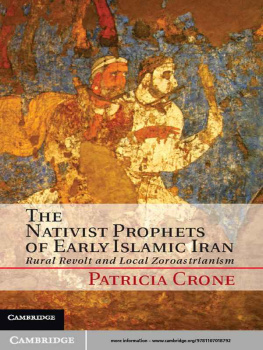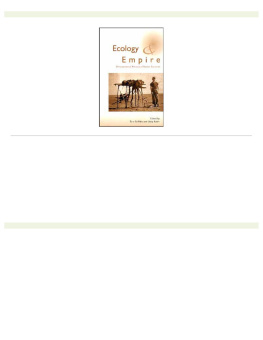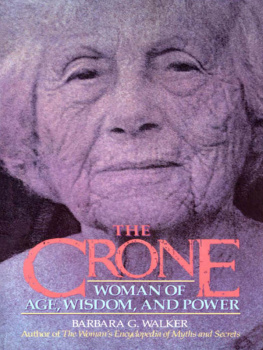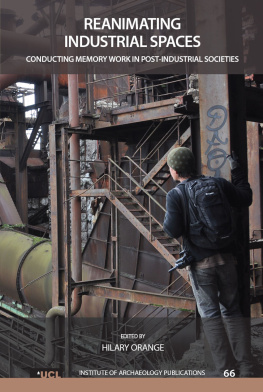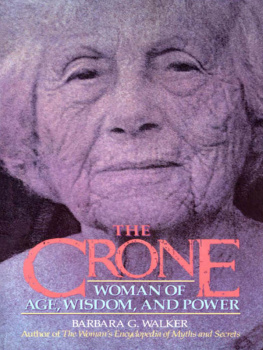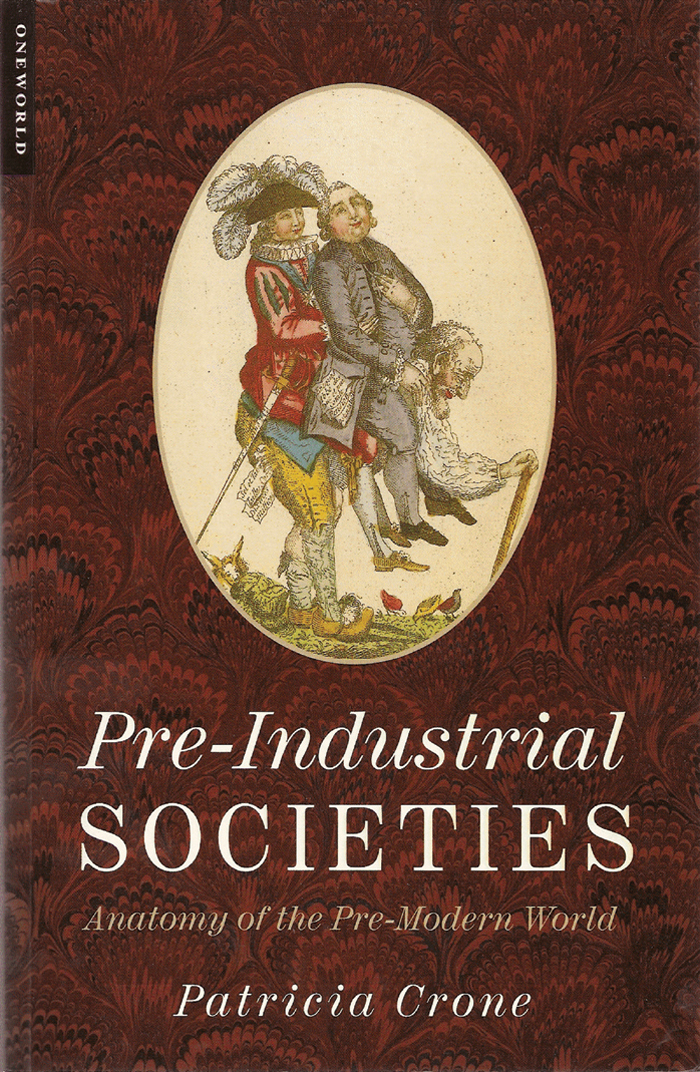PRE-INDUSTRIAL SOCIETIES
Anatomy of the Pre-Modern World
PRE-INDUSTRIAL SOCIETIES
Anatomy of the Pre-Modern World
Patricia Crone

PRE-INDUSTRIAL SOCIETIES: ANATOMY OF THE PRE-MODERN WORLD
This ebook edition published by Oneworld Publications, 2014
First published by Oneworld Publications, 2003
Copyright Patricia Crone 1989
All rights reserved
Copyright under Berne Convention
A CIP record for this title is available
from the British Library
ISBN 9781851683116
eISBN 9781780746906
Cover design by Design Deluxe
Cover picture, A faut esperer qeu jeu la fini ra ben bot
Bibliotheque nationale de France
Oneworld Publications
10 Bloomsbury Street
London WC1B 3SR
England
www.oneworld-publications.com
Stay up to date with the latest books,
special offers, and exclusive content from
One world with our monthly newsletter
Sign up on our website
www.oneworld-publications.com
Contents
For Martin,
who died on December 1, 1988
Preface
The aim of this book is to give students of complex pre-industrial societies an understanding of the constraints under which such societies have operated and the uniformities to which the constraints have given rise. No attempt is made to analyse the specific organization of any one society, let alone all of them, and history is reduced to the role of providing examples. The book endeavours to tell its readers what sort of patterns they should expect to find in the past, not what sort of patterns they will actually find in their particular fields. It is motivated by the consideration that pre-industrial societies evidently should not be approached in the light of modern presuppositions, but that modern students cannot be expected to know which of their own usually unconscious presuppositions they ought to forget. The book thinks away some essential features of industrial civilization and spells out the implications of their absence. The essential features are exceedingly simple, but the implications go far beyond what, in my experience, the average student can work out for himself.
All generalizations are simplifications, and a book which seeks to generalize about societies from the Sumerians to the Manchus must positively oversimplify. I make no apology for this: oversimplifications are precisely what beginners need. If you have no notion what a forest is, it helps to learn that it is a large area covered with trees which make it green, cool and good hiding in, though such a definition would be useless to a forester. It is generally assumed that students of history at university level do know what a forest is, so that they can be plunged straight into the study of this or that particular variety. But mostly they do not, and students of societies which are both pre-industrial and non-European are at a particular disadvantage: they cannot distinguish pre-industrial features of the most common kind from those peculiar to the civilizations with which they are concerned; their sense of what is normal and what unusual (and thus in need of further exploration) is deficient. The book attempts to remedy this deficiency by sketching a picture of what one might call pre-industrial normality; but I must stress that it does so without intellectual pretensions: it offers no stringent model or ideal type, merely a rough-and-ready guide.
I should like to thank Mark Elvin, Ernest Gellner, John Hall, Martin Hinds, Bob Moore and Fritz Zimmermann for extremely helpful comments on earlier drafts; I am particularly indebted to Bob Moore, whose assistance went far beyond that normally volunteered by series editors and several of whose points I have incorporated wholesale. If the result is faulty, it is not for lack of good advice.
Preface to the second edition
A number of misprints have been corrected, and minor changes have been made here and there, but with the exception of statements relating to human evolution, pre-history and contemporary affairs, the text is largely as before.
PC
1
Introduction: What is a Complex Society?
Industry is a mode of production which first appeared in late eighteenth-century England and which proceeded utterly to transform the world at kuge. Most human societies today are either industrial or engaged in the process of industrializing; such wholly non-industrial societies as still exist are archaic pockets doomed to disappear in so far as they have not been placed under preservation order. Most people, and certainly all members of western civilization, are thus born into a world which differs radically from that of their ancestors, with the result that most of human history is a closed book to them. Human history is not very long. The genus Homo emerged about 2.5 million years ago in Africa, from where it proceeded to colonize Eurasia some time before 1 million years ago. But the species Homo sapiens (or H. sapiens sapiens) to which all humans alive today belong descends from an ancestor who flourished as recently as c. 200,000 years ago, probably also in Africa, from where the descendents spread to the rest of the world about years ago, as the first fully modern human beings in both anatomical and behavioural terms. Of those 50,000 years only some 200 years in one part of the world, elsewhere far fewer, have been lived under industrial conditions. We all take the world in which we were born for granted and think of the human condition as ours. This is a mistake. The vast mass of human experience has been made under quite different conditions.
The present work is an attempt to summarize those conditions, or rather some of them. It does not deal with the entire pre-industrial past, partly because there is too much of it and more particularly because primitive (or simple) and civilized (or complex) societies are too different to be treated together.This book is about the latter, and I shall henceforth use the word pre-industrial as a shorthand for pre-industrial of the civilized kind. (Economic historians sometimes distinguish societies on the eve of industrialization from other societies without industry by labelling the former pre-industrial and the latter agrarian; in this book, however, the terms pre-industrial and agrarian will be used synonymously.)
The civilized societies of the past resemble those of modern times, but in some ways the similarity is deceptive. One cannot come to grips with them without thinking away modernity and working out the consequences of its absence. This is precisely what we shall be doing in the following chapters, but before we start, we need to know what a civilized society is. I should like to answer this question by inviting the reader to participate in a simple thought experiment.
Imagine that you and some friends and relatives of yours are shipwrecked on an uninhabited island with no hope of ever getting back. What would you do? Obviously, you would have to start by finding something to eat. The ecology of the island might be such that you could feed yourselves by gathering fruit, berries and other edible plant material, supplementing your diet by hunting or fishing. But if you could, you would start growing things, for agriculture makes for a more dependable food supply than hunting and gathering: cereals such as grain, rice and millet can be stored; and your sedentary mode of life would enable to you to store both these and other things on a scale impossible to those who have to move to wherever prey and plants happen to be available in a particular season. (You might of course still engage in some hunting or fishing from time to time.)


